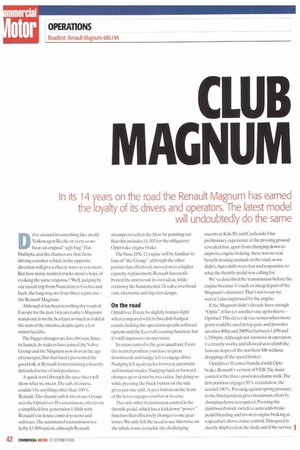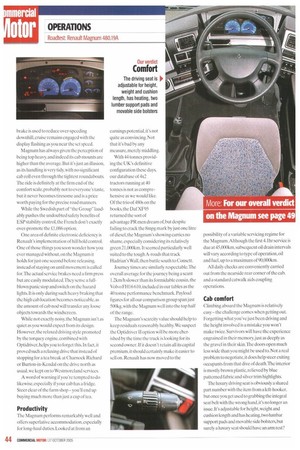CLUB MAGNUM
Page 44

Page 46

Page 47

If you've noticed an error in this article please click here to report it so we can fix it.
In its 14 years on the road the Renault Magnum has earned the loyalty of its drivers and operators. The latest model will undoubtedly do the same
Drive around in something like an old Volkswagen Beetle or even, so we hear, an original "ugly bug" Fiat Multipla, and the chances are that those driving a similar vehicle in the opposite direction will give a cheery wave as you meet. But how many modern trucks stand a hope of evoking the same response? Well. judging by our recent trip from Nuneaton to Gretna and back, the long way, we'd say there is just one the Renault Magnum.
Although it has been travelling the roads of Europe for the past 14 years, today's Magnum stands out from the herd just as much as it did at the start of the nineties. despite quite a few minor facelifts.
The bigger changes are less obvious. Since its launch, its makers have joined the Volvo Group and the Magnum now lives in the age of synergies, But that hasn't prevented the good folk at Renault from retaining a fiercelydefended sense of independence.
A quick trawl through the spec sheet will show what we mean.The cab, of course, couldn't be anything other than lal% Renault.The chassis rails it sits on are Group. as is the Optidriver II transmission, effectively a simplified first-generation I-Shift with Renault's in-house control systems and software.The automated transmission is a hefty £3,909 option,although Renault attempts to soften the blow by pointing out that this includes £1,303 for the obligatory Optibrake engine brake.
The basic 1.3Xi 12 engine will be familiar to fans of-the Group". although the other partner has effectively moved on to a higher capacity replacement. Renault has recalibrated the unit to suit its own ideas, while retaining the fundamental 24-valve overhead cam, electronic unit injector design.
On the road Optidriver II may be slightly feature-light when compared with its Swedish-badged cousin, lacking the operation specific software options and the Eco-roll coasting function, but ifs still impressive in operation.
Its main control is the gear quadrant. From the neutral position, you have to press downwards and nudge left to engage drive. Nudging left again cycles between automatic and manual modes. Nudging back or forward changes up or down by two ratios, but doing so while pressing the black button on the side gives just one split.A grey button on the front of the lever engages crawler or reverse.
The only other transmission control is the throttle pedal, which has a kickdown "power" function that effectively changes to one gear lower. We only felt the need to use this twice on the whole route, to tackle the challenging ascents at Kiln Pit and Castleside. Our preliminary experience at the proving ground revealed that, apart from changing down to improve engine braking, there was no real benefit in using manual on the road, so we didn't. Auto shifts were fast and responsive to what the throttle pedal was calling for.
We've described the transmission before the engine because its such an integral part of the Magnum's character.That's not to say we weren't also impressed by the engine.
If the Magnum didn't already have enough "Optis", it has yet another one up its sleeve Optifuel .This clever device senses when more grunt could be used in top gear, and provides an extra 40hp and 200Nm between 1,050 and 1,35Orpm.Although not intrusive in operation, it certainly works, and allowed us to climb the famous slopes of the northern M6 without dropping off the speed limiter.
Optidriver II comes bundled with Optibrake, Renault's version of VEB.The main control is the three-position column stalk:The first position engages 50% retardation, the second 100%. Pressing against spring pressure to the third position gives maximum effort by changing down as required. Pressing the dashboard mode switch to auto adds brake pedal blending and invokes engine braking at a speed set above cruise control.This speed is clearly displayed on the dash,and if the service brake is used to reduce over-speeding downhill cruise remains engaged with the display flashing as you near the set speed.
Magnum has always given the perception of being top heavy, and indeed its cab mounts are higher than the average. But it's just an illusion, as its handling is very tidy, with no significant cab roll even through the tightest roundabouts. The ride is definitely at the firm end of the comfort scale, probably not to everyone's taste, but it never becomes tiresome and is a price worth paying for the precise road manners.
While the Swedish part of the Group" laudably pushes the undoubted safety benefits of ESP stability control, the French don't exactly over-promote the £1,086 option.
One area of definite electronic deficiency is Renault's implementation of hill hold control. One of those things you soon wonder how you ever managed without, on the Magnum it holds for just one second before releasing, instead of staying on until movement is called for.Thc actual service brakes need a firm press but arc easily modulated.They sense a fullblown panic stop and switch on the hazard lights. It is only during such heavy braking that the high cab location becomes noticeable. as the amount of cab nod will transfer any loose objects towards the windscreen.
While not exactly noisy,the Magnum isn't as quiet as you would expect from its design. However, the relaxed driving style promoted by the torquey engine, combined with Optidriver, helps you to forget this. In fact, it proved such a relaxing drive that instead of stopping for a tea break at Charnock Richard or Burton-in-Kendal on the drive north as usual, we kept on to Westmoreland services.
A word of warning if you're tempted to do likewise, especially if your cab has a fridge. Steer clear of the farm shop—you'll end up buying much more than just a cup of tea,
Productivity
The Magnum performs remarkably well and offers superlative accommodation, especially for long-haul duties. Looked at from an earnings potential, it's not quite as convincing. N ot that it's bad by any measure, merely middling.
With 44 tonnes providing the UK's definitive configuration these days, our database of 4x2 tractors running at 40 tonnes is not as comprehensive as we would like. Of the trio of 480s on the books, the Daf XF95 returned the sort of advantage PR men dream of, but despite failing to crack the 8mpg mark by just one litre of diesel, the Magnum's showing carries no shame, especially considering its relatively green 21,000km. It seemed particularly well suited to the tough A-roads that track Hadrian's Wall, then battle south to Consett.
Journey times are similarly respectable.'The overall average for the journey being a scant 1.2km/h slower than its formidable cousin, the Volvo FH16 610, included in our tables as the 40 tonne performance benchmark. Payload figures for all our comparison group span just 500kg, with the Magnum well into the top half of the range.
The Magnum's scarcity value should help to keep residuals reasonably healthy. We suspect the OptidriverU option will be more cherished by the time the truck is looking for its second owner. If it doesn't retain all its capital premium, it should certainly make it easier to sell on. Renault has now moved to the possibility of a variable servicing regime for the Magnum. Although the first 4.1hr service is due at 45,000km, subsequent oil drain intervals will vary according to type of operation, oil and fuel, up to a maximum of 90,000km.
All daily checks are conveniently carried out from the nearside rear corner of the cab, and a standard catwalk aids coupling operations.
Cab comfort
Climbing aboard the Magnum is relatively easy —the challenge comes when getting out. Forgetting what you've just been driving and the height involved is a mistake you won't make twice, Survivors will have the experience engrained in their memory.just as deeply as the gravel in their skin.The doors open much less wide than you might be used to. Not a real problem to negotiate,it does help steer exiting occupants from that dive of death.The interior is mostly brown plastic, relieved by blue patterned fabric and silver trim highlights.
The luxury driving seat is obviously a shared part number with the item from a left-hooker, but once you get used to grabbing the integral seat belt with the wrong hand,it's no longer an issue. It's adjustable for height, weight and cushion length and has heating, two lumbar support pads and movable side bolsters, but surely a luxury seat should have an arm rest? The non-suspended.swivelling passenger seat gets two.
The Solo Multi-Pass tick box on the order pad covers the specification of the space behind the seats.At the lower level, there is a fully upholstered easy chair on the right side and another padded area on the left. Between them is a fold-down table, which we left folded down as it rattled in the stowed position.
Under the left hand seat is the slide-out fridge. and there is also a false wall which forms an area for hanging clothes.The whole arrangement can be rearranged in best caravan fashion to form the lower hunk,The upper bunk is held up at 450 to extend the downstairs head room during waking hours.The left hand wall also includes a cupboard containing various power supplies and a substantial drop-down shelf with the strength and restraining brackets to securely hold a television set. Next to this is the optional £66 coffee maker.
There's too much storage to list everything, but it includes a large bin beneath the easy chair and a pair of one-third width lockers above the screen.The other third houses the radio and a pre-wired space for a CB. Outside on the left of the ca b, a small locker beneath the forward step and a larger lockable box behind the main steps take care of tools and dirty kit.
No less than four stalks festoon the steering column, which is fully adjustable by pressing a floor button. On the right are controls for cruise control and wipers, and for the standard radio/CD player, which has its display incorporated into the instrument panel.To the left is the usual lights and horn control, together with the stalk for the Optibrake system.
A group of switches to the right of the column include central locking, hazards, hill hold, fuel drain and trailer suzy cheek.Those on the left look after the front roller blind, engine brake mode and extend the operating limit of the traction control from 30 to 50km/h. A large centre console is home to the nonfolding gear lever and park brake. it includes the ashtray, 24V cigar lighter and a usefully deep storage bin.The standard airconditioning system has five fascia vents, hut what look like air vents above the A-pillars are map lights The functions of sun visor and cab curtain arc provided by a set of electrically-operated roller blinds, which have safety stops to prevent them fully lowering while driving. A single convex mirror on the driver's side leaves a small blind spot, but vision is otherwise excellent, helped by the high driving position. •










































































































































































































